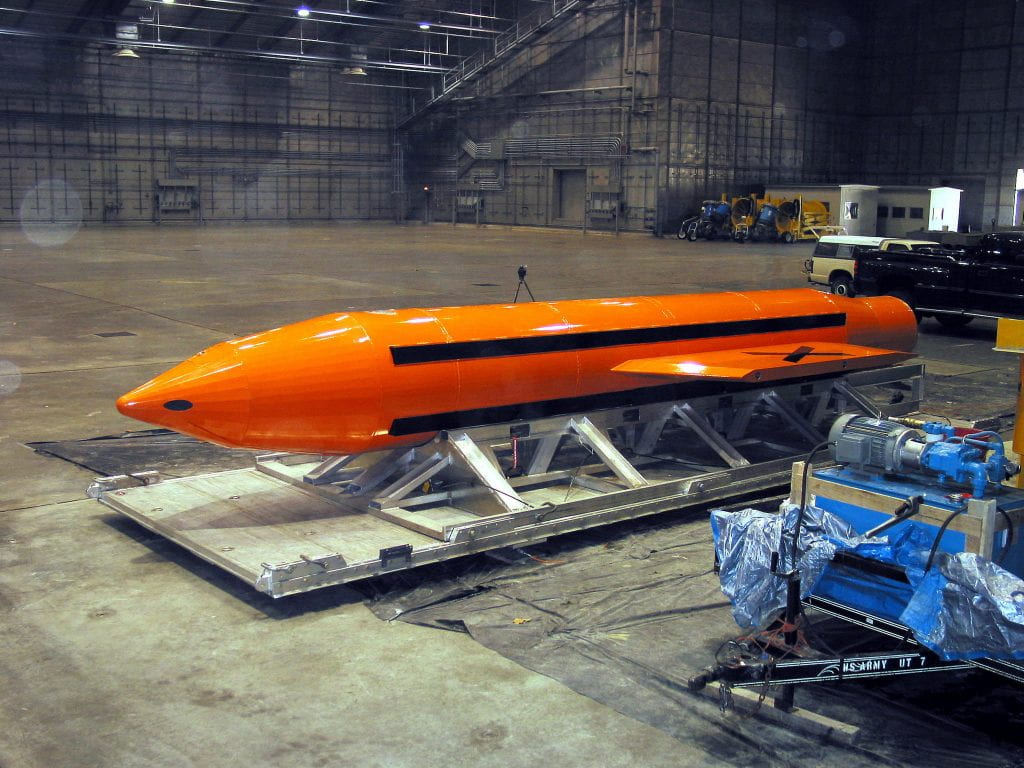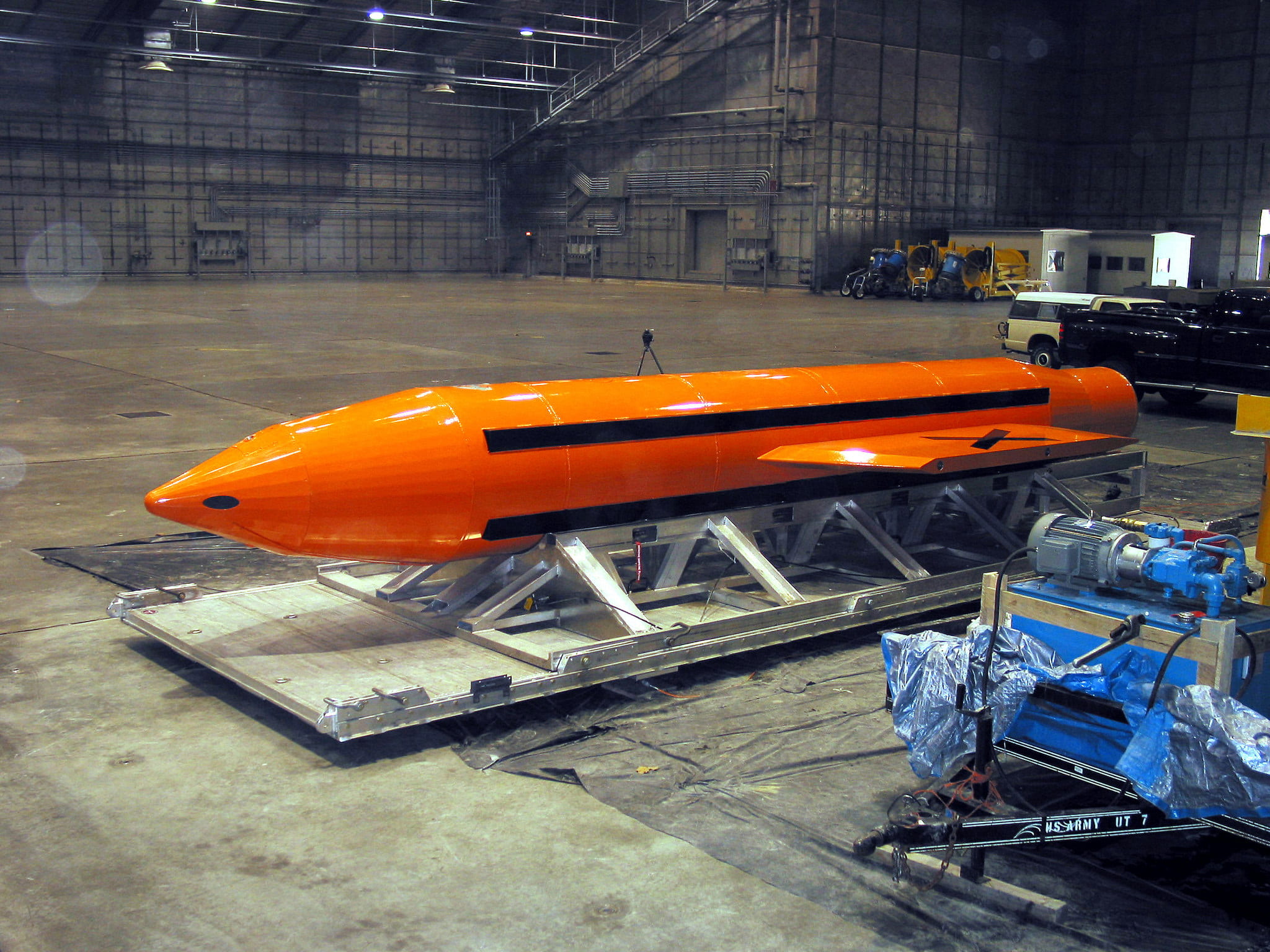BY: Russ Hunter

As the news of the GBU-43/B Massive Ordnance Air Blast (MOAB), nicknamed the Mother of All Bombs, was used in Afghanistan this last week I was at first amused by the commentaries from spin doctors and political pundits from around the world. I found myself dismayed at the lack of understanding of what happens on a battlefield… then came the sensationalism some commentators within my circle were streaming out. I found the comments not only baffling but somewhat maddening. The comments have led me to write this blog. I will use my experience and training to try and explain some of the reasons I think the MOAB was used and why it may be the right tool for the job. I will do this by way of answering five questions that were posed to me.
1. What is the possible reasoning behind this decision? Many different theories are being pursued in the media (to include social media) regarding the reasons behind the dropping of the MOAB. They are that, theories. Some may even reach conspiracy level madness. My professional point of view as a career soldier is that a commander on the ground, who had authority, chose a tool that was best suited for the mission.
I have some concerns with the extreme points of view on both sides of the political spectrum. One side is saying that President Trump has allowed military leaders to assume control. President Trump did not abdicate his authority; he delegated. Those that have served in the military understand this. We also know why we delegate. It is called the span of control. One person is only able to supervise a very limited number of subordinates, that is why there is a chain-of-command. On the battlefield, there is nothing worse than someone who is not there, someone who has no situational awareness or the training and experience saying to a commander: ‘Don’t use that munition, it is not the right one.’ I defer to the battlefield commander in this instance.
The other side is joyfully extolling it as great and about damn time. To those I say, there is nothing great about dropping a massive bomb. The MOAB is a tool and professionals do not brag about how big their bomb is. Get out of the business of bragging and get to the business of bringing the fight to a close as quickly as possible within the limits of jus in bello.
I am sure the political implications are there. Does it send out messages: yes, of course it does. Coupled with the Tomahawk strikes in Syria it sends a very clear message. A message that this is not the same US military posture of the past. It sends a psychological message as well within the battle space and without, we have many tools, and we will use them. So, proceed with caution when you (the enemy) think of attacking X or using Y chemical.
2. The implications of this decision? The implications are multifaceted. I will concentrate on my training and experience. We have a munition that has, at first battlefield damage assessment (BDA), proven to be effective. It is a tool in the commander’s arsenal. The implications for the battlefield are that they will not have to do large area bombings to attain the same effect. The use of the MOAB may be a good thing. The more bombs in the air, the more chance one will miss the target area and harm civilians. The MOAB is proving effective on tunnels and bunkers within the blast area. This may lead the ‘enemy’ to decide that tunnels and bunkers are no longer a safe haven and move out of contested areas. I do caution those who think this will be a game changer in the battle front. We have had that thought before when we shelled an area with such saturation we thought the enemy would be ‘softened.’ That battle turned out to be one of the worst in the Pacific theater in WW II, Iwo Jima. More recently, let us not forget all the munitions dropped on the cave complexes of Tora Bora in Afghanistan, and people thinking Osama bin Laden was dead in a cave.
3. The possible global security – as a human right – implications of this decision? I will hazard an opinion on this. The global security aspect may be the one area whereby using the MOAB may have done the most harm. Though the MOAB is a tactical weapon, the sensationalism surrounding its use causes me concern. The comparison to a nuclear weapon gives the impression that it is more destructive than it truly is. This comparison can raise fear in places like North Korea and Iran. I am afraid those who want to vilify the US and the West will use the sensationalized articles and soundbites from pundits within their propaganda machine. We have already seen the rise of tensions on the Korean peninsula and Iran’s recent unveiling of a new fighter jet with the accompanying rhetoric with its debut. The human right aspect to all of this I fear will be the loss of life.
4. Was this a violation of international law, given that there was no direct threat to the US? This one is easier to answer. There is no violation of international law. Afghanistan is a recognized conflict zone. The conflict is being waged under a coalition support force. This coalition has been granted through a status of forces agreement (SOFA) between the US and the Afghanistan government. The US/Afghanistan agreement is coupled with the SOFA agreement between NATO and the Afghanistan government. This legally allows NATO and the US to be there to assist the Afghanistan government against insurgents. The MOAB is not on the list of banned weapons; it is a conventional bomb. The two central jus in bello principles are satisfied: Discrimination and proportionality. Discrimination: Was it a legitimate target? Yes. Proportionality: Was the force morally appropriate? Yes. You may argue against this view but the commander weighed out what it would take in human lives to clear out this tunnel complex. The commander determined the MOAB as the best tool to save those lives under his command.
5. Is it possible this was a good decision? I think anything is possible. In this particular case, yes it was a good tactical decision as qualified by the combatant commander. As a strategic decision or a political decision; that warrants further consideration. As the rhetoric spins up and sabers are rattled, it can become problematic. The decision to use the MOAB may prove, in the end, not to have been a good decision outside of the combat zone (Question 3).
Once again I caution equating this weapon to more than it is. First off, it is a conventional weapon. Delivered by conventional means. It is not a banned weapon nor is it something that changes the strategic landscape. Bear with me here. To use this particular weapon, you have to have air superiority, control the skies. It is not self-propelled. It is not launched via a submarine. It is not an inter-continental ballistic missile (ICBM). It is not radioactive. It is not chemical (as in banned chemical weapons). It is not a biological weapon. However, as long as the media sensationalizes and people do not educate themselves as to what this weapon is, a tactical weapon, we will have questions about its use and when is it a good decision to use it.
The last issue I wish to expound upon is this notion of the comparison of the MOAB to a nuclear weapon. Let me be blunt. Whoever does this type of comparison is disingenuous about what the differences are between a conventional bomb and a nuclear bomb. They are keeping to a political narrative, or they are ideologues who cannot see past their entrenched views. The comparison is by no means within a reasonable frame as comparable to a nuclear bomb.
Yes, it is a tool of war and no, I do not see it as a push of boundaries of nuclear and conventional bombs. The MOAB is around 11 tons of TNT while the Hiroshima nuclear bomb was 15,000-16,000 tons of TNT (equivalent – it was not a TNT bomb) or better understood as Hiroshima at 15-16 kilotons and MOAB at 0.1-0.2 kilotons. No radioactive material involved. I do understand the concern about the use of such weapons, but I feel we must not conflate the abilities. I have seen 500-pound bombs detonate and fully appreciate the destructive power that the MOAB represents but the MOAB is not close to a nuclear event, and it does not help the debate to misrepresent its destructive power.
The debate about the MOAB should be in two realms. First, is it a good tactical weapon that helps the combatant commander achieve his goals? Second, if it is a strategic decision to use a tactical weapon, then we should be debating why and what its function is. If it is not the right tactical weapon for use on a target and is not proportional but used to make a strategic point, then we need to debate the jus in bello principles. Now I ask a question to you the reader. Consider the just war theory principle of winning the war as quickly as possible, while adhering to jus in bello requirements. This principle requires us to ask: Why would you not use the MOAB as a tactical weapon if it can bring this prolonged war to a close?
Russ Hunter Expertise: Civil/Military Operations, Intelligence, WMD Operations
Russ is currently in the Masters in Peace and Conflict Studies program at the University of Otago. He holds a Master Degree in Liberal Arts from the University of Richmond, a Post Grad Certificate from the University of Stirling, Scotland and is a graduate of the U.S Army Sergeants Major Academy. He retired from the U.S. Army as a Sergeant Major in 2009 with over 24 years of distinguished military service in both Operations and Intelligence. He has been a guest lecturer at the University of Richmond. The titles of Russ’ past lectures have been Drone Strikes: A Case for a Moral Response, Evolution of Unmanned Air Systems (Drones in the Sky), and Counterterrorism/Antiterrorism Strategy. He co-taught a Drone law course for law, paralegal and Masters students. Russ has multiple awards and citations both professional and academic.

